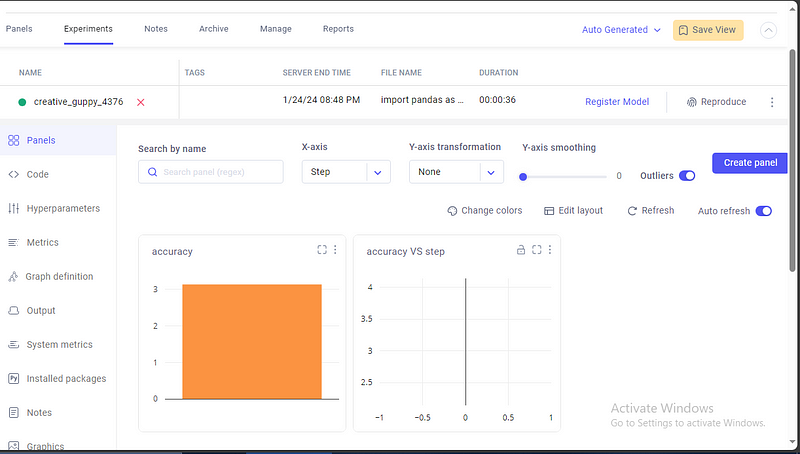Building a Social Media Sentiment Analyzer: Understanding Emotions in Online Conversations

In today’s digitally interconnected world, where online conversations shape public opinions, understanding the underlying sentiments in social media interactions is paramount. The ability to discern emotions expressed on platforms like X/Twitter, Facebook, and Instagram is valuable for individuals and holds immense significance for businesses, marketers, and researchers.
In this article, I will introduce the development of a Social Media Sentiment Analyzer — a powerful tool designed to unravel the emotional nuances embedded in online conversations. Leveraging the capabilities of Python and Comet, a robust platform for ML experiment tracking, this project aims to provide insights into the sentiments prevalent in social media interactions.
Understanding Sentiment Analysis
Sentiment analysis, commonly called opinion mining, is a computational technique to determine the emotional tone embedded within a text. In the dynamic landscape of social media, where vast amounts of user-generated content are shared daily, sentiment analysis becomes a crucial tool for deciphering the sentiments expressed in online conversations.
Understanding sentiment holds substantial significance across various domains. One key aspect is its role in decision-making support for businesses. Organizations can make informed, data-driven decisions by analyzing customer sentiments toward products or services. Additionally, sentiment analysis is pivotal in brand reputation management, allowing businesses to monitor and enhance their public image proactively.
Despite its significance, sentiment analysis faces inherent challenges. Contextual ambiguity, stemming from language nuances and context-dependent meanings, poses a hurdle in accurately determining sentiments. Detecting sarcasm and irony adds complexity due to their non-literal nature, requiring sophisticated algorithms to grasp the intended meaning.
Sentiment analysis employs various methodologies, each with a unique approach. Traditional machine learning for sentiment analysis employs algorithms trained on labeled datasets to categorize text sentiments as positive, negative, or neutral based on learned patterns. While robust, this method may require substantial labeled data. In contrast, VADER takes a lexicon-based approach, utilizing a pre-built sentiment dictionary with associated scores for words. This method is quick and efficient, suitable for tasks where simplicity is crucial. However, it may struggle with nuanced language and context. The choice between the two approaches depends on the specific needs of the sentiment analysis task, considering the distinctions between positive, negative, and neutral sentiments.
In the context of social media, sentiment analysis holds practical applications. The ability to provide real-time insights into how users are responding to events or trends is invaluable. Social media sentiment analysis facilitates marketers in assessing the effectiveness of campaigns by analyzing the sentiments expressed by the audience. It is a powerful tool for gauging public opinion and adapting strategies accordingly.
1. Installing Required Packages:
These packages include NLTK, Comet, Scikit-learn, Pandas, Matplotlib, Seaborn, and any additional libraries your project may require. Use the following command:
pip install nltk comet_ml scikit-learn pandas matplotlib seaborn
2. NLTK Data Download:
NLTK requires additional data for various language processing tasks. Download the datasets needed by running the following Python script:
import nltk
nltk.download('punkt')
nltk.download('stopwords')
3. Comet Account Setup:
To utilize Comet for experiment tracking, create an account on the Comet website. Once registered, obtain your API key from the Comet dashboard. This key will be used to authenticate and log experiments.
Accessing Twitter Data
In social media sentiment analysis, Twitter is a treasure trove of real-time conversations. This section guides you through accessing Twitter data, a pivotal step in our journey to understand emotions in online discussions.
- Twitter API Access:
To access Twitter/X data programmatically, you must create a Twitter Developer account and obtain API credentials. Follow these steps:
- Go to the Twitter Developer Portal and make a new app.
- Once created, navigate to the “Keys and tokens” tab to obtain your API key, API secret key, Access token, and Access token secret.
2. Tweepy — Twitter API Wrapper:
Tweepy is a Python library that simplifies the interaction with the Twitter API. Install Tweepy using the following command:
pip install tweepy
3. Authenticating with Twitter API:
Utilize Tweepy to authenticate your access to the Twitter API using your obtained credentials. This authentication is crucial for making requests to the API and retrieving relevant Twitter data.
import tweepy
# Replace these with your own credentials
consumer_key = "your_consumer_key"
consumer_secret = "your_consumer_secret"
access_token = "your_access_token"
access_token_secret = "your_access_token_secret"
# Authenticate with Twitter
auth = tweepy.OAuthHandler(consumer_key, consumer_secret)
auth.set_access_token(access_token, access_token_secret)
api = tweepy.API(auth)
4. Retrieving Tweets:
With authentication, you can now use Tweepy to retrieve tweets based on specific keywords, hashtags, or user accounts. For instance, to fetch recent tweets containing a particular hashtag:
# Fetch tweets with a specific hashtag
tweets = api.search(q='#sentimentanalysis', count=10)
# Print tweet text
for tweet in tweets:
print(tweet.text)
By seamlessly integrating Twitter API access into our sentiment analyzer, we gain direct access to the pulse of online conversations. This step lays the groundwork for the subsequent analysis, where we’ll apply sentiment classification techniques to unveil the emotional undertones in the gathered Twitter data.
Building the Sentiment Analyzer:
Now that we’ve successfully accessed Twitter data, the next crucial step is constructing the sentiment analyzer. This section delves into the implementation details, leveraging Python and Comet for an efficient and insightful sentiment analysis process.
Once data is collected, the retrieved data can be stored in a structured format, such as a CSV, ready for further processing and sentiment analysis in subsequent steps. Proper data collection lays the groundwork for effectively understanding emotions within online conversations and deriving meaningful insights from them.
For this example, we will use sample data from Kaggle to build the Social Media Sentiment Analyzer.
Loading and Preprocessing the Data.
import pandas as pd
# Specify the path to your CSV file
csv_file_path = r'C:\Users\thinkcentre\Desktop\Tweets.csv' # Update the file name to "Tweets.csv"
# Load the CSV data into a Pandas DataFrame
df = pd.read_csv(csv_file_path)
# Display the first few rows of the DataFrame to inspect the structure
print(df.head())
Explore and Understand the Data:
# Get basic information about the DataFrame
print(df.info())
# Check for missing values
print(df.isnull().sum())
# Explore the distribution of sentiments in the dataset
print(df['airline_sentiment'].value_counts())
Preprocess the Text Data:
import nltk
from nltk.corpus import stopwords
from nltk.tokenize import word_tokenize
# Download NLTK resources
nltk.download('stopwords')
nltk.download('punkt')
# Text preprocessing function
def preprocess_text(text):
# Tokenization
tokens = word_tokenize(text)
# Remove stop words
stop_words = set(stopwords.words('english'))
filtered_tokens = [word for word in tokens if word.lower() not in stop_words]
# Additional preprocessing steps can be added based on specific needs
return ' '.join(filtered_tokens)
# Apply text preprocessing to the 'text' column
df['processed_text'] = df['text'].apply(preprocess_text)
Perform Sentiment Analysis with VaderSentiment:
VaderSentiment is a powerful tool for sentiment analysis, especially suitable for social media content. It categorizes text as positive, negative, or neutral and provides a compound score representing the overall sentiment. Install VaderSentiment using:
pip install vadersentiment
from vaderSentiment.vaderSentiment import SentimentIntensityAnalyzer
# Initialize the sentiment analyzer
sia = SentimentIntensityAnalyzer()
# Analyze sentiment for each row and create a new column 'compound_score'
df['compound_score'] = df['processed_text'].apply(lambda x: sia.polarity_scores(x)['compound'])
Integrate Comet into Your Code:
from comet_ml import Experiment
experiment = Experiment(
api_key="Comet API",
project_name="building-a-social-media-sentiment-analyzer",
workspace="innocent"
)
# Report multiple hyperparameters using a dictionary:
hyper_params = {
"learning_rate": 0.5,
"steps": 100000,
"batch_size": 50,
}
experiment.log_parameters(hyper_params)
# Or report single hyperparameters:
hidden_layer_size = 50
experiment.log_parameter("hidden_layer_size", hidden_layer_size)
# Long any time-series metrics:
train_accuracy = 3.14
experiment.log_metric("accuracy", train_accuracy, step=0)
# Run your code and go to /

Running the Sentiment Analyzer
Now that we have preprocessed the analysis, it’s time to run the sentiment analyzer and gain insights into the sentiments expressed in the dataset.
1. Loading the Model:
Before running the sentiment analyzer, ensure you have loaded the required libraries and the sentiment analysis model.
# Assuming you have saved your sentiment analysis model
from sklearn.externals import joblib
# Load the trained sentiment analysis model
model = joblib.load('sentiment_analysis_model.pkl')
Applying the Model:
Apply the loaded model to analyze sentiments on new data.
# Assuming 'new_data' is a DataFrame containing new text data
new_data['processed_text'] = new_data['text'].apply(preprocess_text)
# Predict sentiments using the loaded model
new_data['predicted_sentiment'] = model.predict(new_data['processed_text'])
Visualizing Results:
Visualize the results to gain a comprehensive understanding of sentiment distribution.
import matplotlib.pyplot as plt
# Plotting sentiment distribution
plt.figure(figsize=(8, 6))
new_data['predicted_sentiment'].value_counts().plot(kind='bar', color=['green', 'red'])
plt.title('Sentiment Distribution')
plt.xlabel('Sentiment')
plt.ylabel('Count')
plt.show()
Comet Integration:
# Log predictions to Comet
experiment.log_table(
'Predictions',
new_data[['text', 'predicted_sentiment']].head(10).to_markdown(),
)
Conclusion
In the dynamic realm of online interactions, gaining insights into the sentiments expressed in digital conversations is critical. Creating a Social Media Sentiment Analyzer using Python and Comet marks a significant stride in leveraging machine learning for in-depth analysis. As we explore developing and tracking this sentiment analyzer, it’s essential to reflect on key takeaways and consider future possibilities.
Future Possibilities:
1. Future endeavors could focus on integrating more advanced features and models to enhance the accuracy and nuance of sentiment analysis. Experimenting with deep learning architectures and embeddings can further capture intricate linguistic patterns.
2. The sentiment analyzer’s capabilities can be extended by incorporating data from diverse sources. This could encompass additional social media platforms, customer reviews, or industry-specific forums, broadening the scope of analysis.
3. A potential avenue for development involves creating interactive dashboards for visualizing sentiment trends over time. This would empower users to explore and analyze the evolving landscape of online sentiments dynamically.
4. Leveraging Comet’s collaborative features opens doors to shared analysis. Collaborators can be invited to collectively explore insights, share observations, and derive meaningful conclusions from the sentiment analysis results.
The development of a Social Media Sentiment Analyzer underscores the potency of combining Python’s analytical prowess with Comet’s project tracking capabilities. Embracing the advancements in sentiment analysis technology propels us towards a deeper understanding of the digital sentiments that shape our interconnected world. As we progress, these insights hold the potential to inform and influence decision-making in various domains.
References
- Sheikh, Mahnoor. “Top 15 Sentiment Analysis Tools to Consider in 2024.”
- Pascual, Federico. “Getting Started with Sentiment Analysis using Python.” Published February 2, 2022.
- Naushan, Haaya. “Sentiment Analysis of Social Media with Python.” Published on January 16, 2024. Toward Data Science.
- Mogyorosi, M. (2021, January 13). “Sentiment Analysis: First Steps With Python’s NLTK Library” in Real Python.


